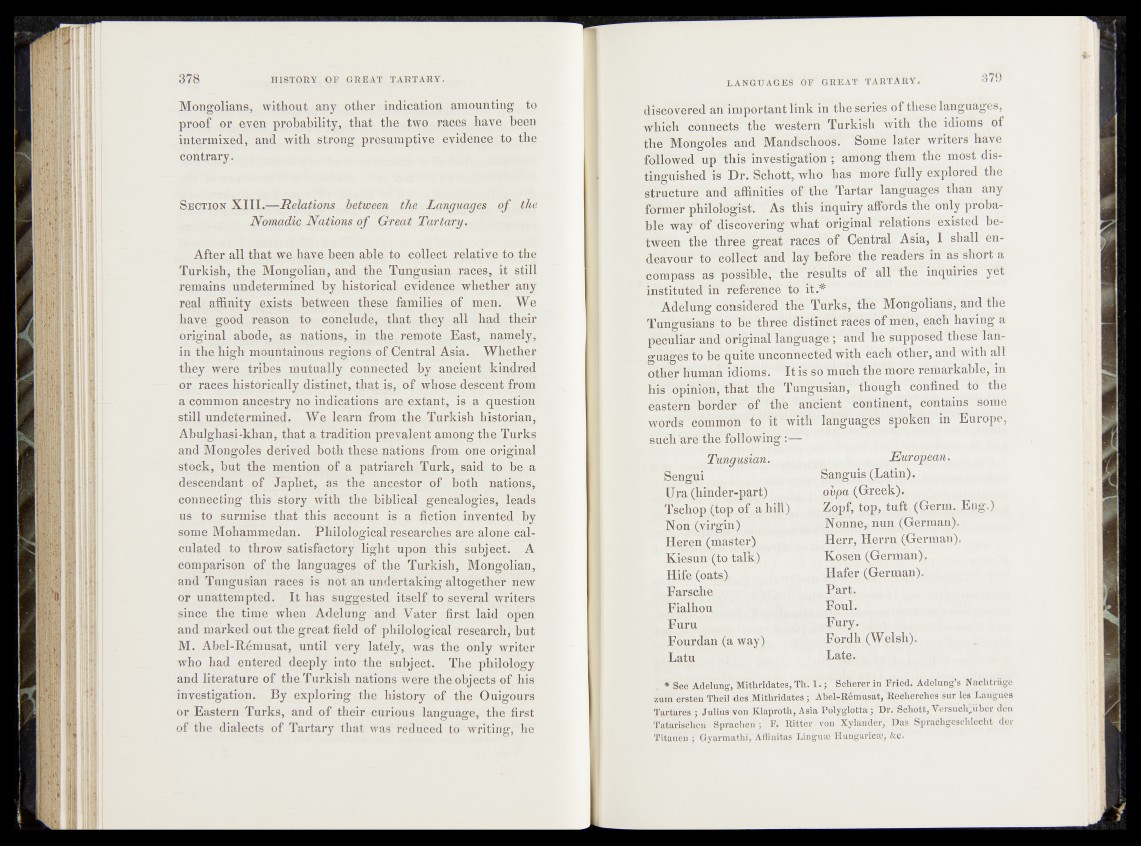
Mongolians, without any o||ier indication amounting . to
proof or even probability, that the two races have been
intermixed, and with strong presumptive evidence | q , the
contrary.
S ection XIII.—Relations between, the Languages of the
Nomadic Nations of Great Tartary.
After all that we have been able to collect relative to the
Turkish, the Mongolian, and the Tungusian races, it still
remains undetermined by historical evidence whether any
real affinity .exists between tfye&e families^. of men. We
have good reason to conclude, that they all had their
original abode, as nations, in the remote, East, namely j
in the high mountainous regionsjof Central Asia. Whether
they were tribes, mutually, connected by ancient kindred
or races historically distinct, t.haLig, of whose, descent from
a common ancestry no indications are ex-tantv is ,a -question
still undetermined. We learn from the Turkish historian,
Abulghasi-khan, that a tradition prevalent among the Turk®
and Mongoles derived both these nations from one original
stock, but the mention of a patriarch Turk,- said to taya
descendant of Japliet, as the ancestor of Tioth nations,
connecting this story with the biblical genealogies, leads
us to surmise that this account is a jpctiOn invented by
some Mohammedan. Philological researches are alone calculated
to throw satisfactory light upon this subject. A
comparison of the languages of the Turkish, Mongolian,
and Tungusian races is not an undertaking altogether new
or unattempted. It has suggested itself to several writers
since the time when Adelung and Vater first laid open
and marked out the great field of philological research, but
M. Abel-Remusat, until very lately, was the only writer
who had entered deeply into the subject. The philology
and literature of the Turkish nations were the objects of his
investigation. By exploring the history of the Ouigours
or Eastern Turks, and of their curious-language, the first
of the dialects of Tartary that was reduced to writing, he
dfisfeb'vered an inffibrtantlink in thekeries of these languages,
which i:^ ^ b r n Turkish with the idioms of
the^Iongoles and Mandschbq^’'" !Some later writers have
f$llowe<tsup thiy 'mWflf^ation ; ‘ amdiri^them the most dis-
tihguisl^'d^fs5 Drls^ ’hj^t, who has moffe fully explored the
structure and affinitfei^ of'the Tartar lan^^ges than any
former philol^^sl!"'’ As this inquiry affords the dftly probably
way' of disboVe^ing^what^rTgihal" ? e l^ ^ ^ vexisted between
the' three grehf races of^’^ ^ tr a l Asia, I shall'endeavour
to collect and layTO#e" the wffe^s in askhorta
^mp a ss a,s" possible, the^^sullk of all flife inquiries yet
’ i'nltitutfl3 in
1 Adelung consideVyff/'ihe ThrS^' lhel Mq^olians, and the
Tungusiahs to be'three1 diS^nWtf a ^ s of m6h;4hach fhavihg a
pibmMr Snd original ik f f ^ a ^ ; aha he supposed these la#l
_^dages to m quite unconnected wifhfeach btffeyJ, and |mhr all
other human idioms . It is* so much t8^n(^p remarkable, in
his'opihiOn, that the T^nghSatf,, tbdugt f ,confin^ ^ fil the
eastern ^border* Vff ' t h e ^ ^ ^ ^ , c 6 n t i h e ^ ^dntain^4some
w ^ f^ fm m d n 'rtso it with '^® a ^ h s sphkW in Europe,
such hr e the following ;;^2r r
fungmian.
Sengui
U çaifipder-part)
Tsçhop (top of a hm)t
Non ftnrgin) ^
Heren*(hiaster)
Kiesun (to talk),
Hife (oats); ,
Farsche
Fialhou
Furu
Fourdan (a way\if';,
Latu
Æufopfian. t
Sangms (Latin), j
,oùpae(Greek)|| f
Zopf, tg]|, tu |t (^©i^m^^ng. )
^Nonne^n^(German). ,
Herr, Herrn (0çrman).
Kosen (german).
Hafei; (Gerqian)..^,
Part.
Fury.
F q ï^ h j^W e ls h ) ..
Late.
* See Adèluüg, Mithridatès, Th. 1.; höherer in Fried.' AdSÜung’s Nachträge
ztttfl ersten Theilfe# » tkr id a tesj ABhl^lnusiät, Recherches sar les Langües
Tartares ; Julias von Klaproth, Asia Pül||lotta'; Dr^Sch'ött, V'ersach^über den
Tatarischen Sprachen j F. Ritter von Xylander, Das Sprachgeschlecht der
Titanen ; Gyarmathi, Affinitas Linguee Hungaricse, &c.